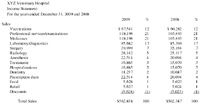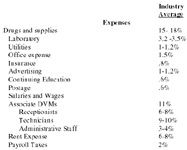Financially beating the economic downturn (Proceedings)
As we have moved through 2009, veterinary practices continue to feel the effects of the economy.
As we have moved through 2009, veterinary practices continue to feel the effects of the economy. The direct correlation to what is happening in most hospitals is the result of the current job market and the fact that consumers remain shy about spending money. Consumer confidence remains low. Unemployment is hovering at 10% or more in many areas. It is not until you read in the newspaper that there is a turnaround in unemployment and an improvement in consumer confidence will you see positive revenue changes begin to take place. The average invoice will provide the support for maintaining sales and invoices will continue to modestly decline. Please remember, this is a time where you should not hold back on price changes. Inflation pressures will continue. Inflation pressures should continue to call for 2009 price increases of at least 5%. With no growth in sales and continued increases in costs, profit margins in most hospitals will be squeezed. Many who run their practices by their checkbook may not even realize until the end of the year the full effect that economy has had on their practice.
The major impact of the economy in most hospitals is that many are experiencing a decrease in invoices while maintaining the same or increasing average invoice. The increase in the average invoice is mostly coming from price increases. So what should practices do to weather the storm?
Build strong relationships with your client base so price is not an issue. These times will give clients who are on the fence with your practice a reason to find a new and maybe less expensive provider. Train your staff to excel at client service. Hold more staff meetings to discuss these issues.
Do not change your medical protocols based upon the economic conditions. Continue to offer exceptional care and let clients tell you they cannot afford the best of care before offering alternatives.
Shore up reminder systems so clients do not fall through the cracks. Make sure all clients have standard reminders set up. Run reports monthly to make sure that all do. What is your year to year client return ratio? Track those clients who are responding to first, second and third reminders. For those who are not responding to any reminders, consider a phone call or a personal letter explaining why it is still extremely important to continue the yearly visit. Owners of the practice should personally sign the letters. Re- remind clients who have not been to the practice in the last six months. Do not let those past due on reminders fall out of the system.
Close the hole on missed charges. This a time where it is extremely important to make sure you are getting paid for the services you provide. Conduct daily chart audits and compare to the charges on client invoices. Use automation to assist you with this process.
Shop for products and services the hospital purchases to make sure you are paying the appropriate amount. Competitively bid for best price where you can.
Make sure you are reserving at least 30 days of expenses in cash to weather the downturn. Keep an open line of credit at the bank to handle any cash flow issues. You need the line in place before you have issues.
Review your use of staff scheduling and cut out unnecessary overtime. Use payroll budgets to assist with monthly scheduling of hours for each payroll area (IE: Technicians, receptionists, animal handlers, etc.)
Consider more external marketing to keep up the new client numbers. Look at a comparative analysis of new clients every month. It is important to determine where these new clients are coming from and what type of marketing works in your practice. Have your staff prepare a report for your use once a month to determine what works. Check to make sure your web presence is good and make sure potential clients can easily find you from an internet yellow page listing that is tied to your web site. How are your signage and the exterior of your building? Street presence is still in the top three of ways potential will find you and consider using your services. Get involved in your community through local community organizations and church groups and volunteer to provide lectures to community organizations such as Boy Scout and Girl Scout groups. Also determine if you can provide talks in the local schools. Where ever you go make sure you have plenty of business cards and hospital brochures.
Understand your financial to look for strengths and weaknesses in both the revenue streams and expense streams.
Income of the practice
Where does the practice generate its income from? Use your veterinary software to tell you. Analyze it monthly and track it in your accounting software (QuickBooks).
A hospital revenue analysis within the financial statement might look like the following:

When hospital revenue areas look weak, look for issues within control systems to make sure all income is being earned.
Here are items to consider in each area
Clinic services
1. Are fees for exams and vaccines separated and charged appropriately?
2. Are sick pet visits charged when a medical issue arises but started as a wellness exam?
3. Do medical exams which are extended for eye, neurological, or orthopedic reasons become extended exams and charged as such?
Pharmacy
1. Revisit mark-ups on drug and medical supplies
2. Revisit hospital dispensing fees. Does the hospital have: A counted and label fee? A separate label fee for items sold in full bottles or tubes?
3. Does the hospital have set minimum prescription prices?
Diagnostics
1. Do X-Ray prices include an interpretation fee?
2. Does the hospital charge for different size films and additional views?
3. Does the hospital add on clinic expenses when outside ultrasound specialists come in to do procedures?
Hospital services
1. Are surgeries and anesthesia procedures timed and billed accordingly?
2. Do hospitalization fees incorporate time spent by the nursing staff and the DVM?
3. Are hospitalization fees considered for day cases as well as overnight cases?
Lab services
1. Revisit mark-ups on outside lab services. Are prices current with outside lab price schedule?
2. Do in house lab prices reflect the cost of the test, equipment and related payroll costs to run and interpret test results? Are invalid tests considered a part of the cost of service?
Over the counter sales
1. Revisit mark-ups on all items.
Hospital fees and discounting
Owners and associates should be reminded that they have a responsibility to adhere to their fee schedule. This point should be stressed to the associates, if not made a part of their contracts. If an associate has an issue with hospital fees, it should be either brought to a doctors meeting for a resolution amongst all or brought to management's attention in a one-on-one session. The use of hospital estimates should be mandated. Clients need a clear understanding of expected charges. When clients receive unexpected bills, they get angry. This usually creates billing issues and eventually bad debts. Bad debts reduce the bottom line.
With most veterinary software monthly accounts receivable reports can be created on a per-doctor basis. These should be printed for each doctor so they may review the status of unpaid balances related to their clients. This does not mean they need to have the responsibility to collect the account but certainly be made aware of it and to assist with collection when appropriate. Practice owners should also share with associates how much of their accounts receivable are written off each month. Hospital accounts receivable for small animal companion hospitals should never exceed 2.5% of the hospital's revenue and not more than 11% for large animal practices.
To further assist practice owners and associates, if the veterinary software allows, a daily fee exception report should be run by doctor to monitor fee overrides. This information should be shared with all doctors. Fee overrides should not be permitted.
Also, practices should monitor all manual discounts given. These should not be allowed. To alleviate any ill will regarding compassionate care, a doctor charity account can be set up for each associate for which they have the ability to use for free or reduced fee care. We recommend a $1,000 limit per doctor.
Expenses of the practice
You cannot make money cutting expenses in a hospital. The best you can do is to control them. Budgeting is the best way to do that. Also, benchmarking your practice to the industry averages will let you know if you are in line with others. Below are the industry averages for the most common expenses.
